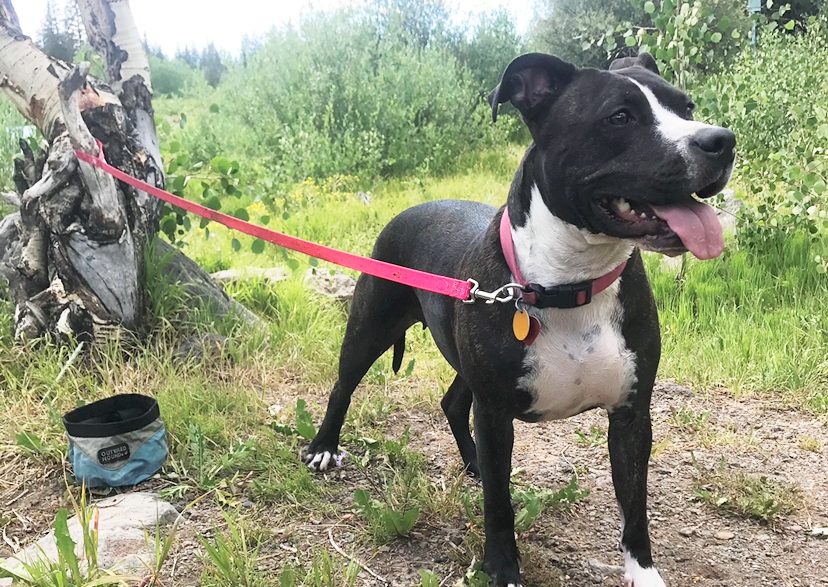We all love to take our animals on walks, and sometimes the dog park just doesn’t cut it. Taking your pet (yes, even some cats!) on a hike is incredibly enriching as they encounter new smells, sights, and textures, which improves their mental health. But before hitting the trails with your pet, keep in mind these few tips to protect both your pet and the animals who call the area home.
Pick a trail that allows pets.
Some areas, like the Colorado National Monument, don’t allow pets to hike on the trails in order to keep the area clean and preserved. I recommend hiking within McInnis Canyons National Conservation Area, Bangs Canyon, James M. Robb State Parks, Riverfront Trail, Highline Lake State Park, or even the Grand Mesa, all of which are pet-friendly. (Bonus tip: you can check out a state parks pass for free from Mesa County Libraries!)
Leave no trace.
Follow the principles of Leave No Trace — including disposing of waste properly and leaving what you find. Stick to the rule, “carry in, carry out.” Don’t leave behind items such as your dog’s feces, baggies, or treats. Always carry grocery bags or poop bags to be able to pick up your dog’s feces. It’s important to bring your own rather than counting on the trailhead to supply these items, since many places do not. Once you’ve picked up your animal’s feces, always throw it away in a trash can to be disposed of properly, even if that means driving it back home with you. It’s also important to not leave behind any of your pet’s treats or food. When you leave behind these things, it can attract wildlife to the trail, which can be dangerous to other hikers and their pets.
The only thing you should be removing from the trail is trash — don’t steal from Mother Nature! Antlers are a popular thing to take while hiking, and yes, my dog likes to chew on them, too. However, antlers provide a large amount of nutrients back into the environment when they decompose. So while it might be tempting to take them home either for your dog to chew on or for decoration, it’s best for the environment to leave them behind.
Leash up and be mindful of wildlife!
Protect wildlife by keeping your pet under your control using a leash. Wild animals may be startled, disturbed, or harmed by curious pets and people, especially in the springtime when animals are newborn or nesting. This is just one of many reasons why it’s important to keep your pet on a leash and remain on-trail. If your pet meets a wild animal on the trail, being on a leash will keep them from chasing and getting lost or hurt by a predator. If you and your pet encounter a predator like a bear or mountain lion, it is dire that you and your pet do not run away from it. Running from a predator can trigger their primal instincts to chase you as prey. Rather than running, slowly back away from the predator, make yourself appear larger, and use a deep, loud voice to scare them away. Another tip to help in a situation like this is to equip your dog with bear bells. These bells not only help keep track of your dog it they get loose, but alerts wild animals to your presence to protect your pet from wild animals and protect wild animals from your pet. In most cases, if an animal is not surprised by your presence, they will mosey away and avoid any type of interaction. Always keep your eyes on and around the trail for fresh tracks and scat. And always carry bear spray just in case! In Colorado specifically, there are a few animals you should watch for: black bears, mountain lions, elk, bighorn sheep, birds of prey, wild horses, and moose. Click here for more information about encountering specific animals while hiking with a pet.
Keep your pet up-to-date on vaccines and tick prevention.
In 2021, 84 animals tested positive for rabies in Colorado. Rabies, Latin for “to rage,” is a viral, fatal disease that affects the host’s nervous system. Rabies only affects mammals. It is imperative (and required by law!) that your pet is vaccinated against rabies in the rare case they encounter a rabid animal. In Colorado, the most prevalent species that carry rabies are skunks and bats. However, foxes, raccoons, bobcats, coyotes, and any other mammal can also be carriers. And don’t worry, being sprayed by a rabid skunk, despite how awfully stinky that would be, cannot infect you or your pet with rabies. It is only transmittable when a rabid animal’s saliva enters another animal’s blood stream, most commonly through a bite. Symptoms of rabies include agitation, biting or snapping at real or unreal objects, excessive drooling, appearing tame, lack of fear towards humans, wobbly, lethargic, partially paralyzed, disorientation, self-mutilation, and seizures. If you notice any animal, whether wild or domestic, experiencing these symptoms, leave them alone and contact animal control or a forest service.
Ticks, while relatively rare in western Colorado compared to other areas of the country, can cause health issues for your pet, especially if you hike in wooded areas like the Grand Mesa in the summertime. Ask your veterinarian about appropriate tick preventative before heading out into the wilderness. Click here to learn more about ticks and the health risks they carry in Mesa County.
Hiking is a fantastic way to strengthen the bond between you and your pet, so stay safe, respect our lands, and have fun in this beautiful area that we live in!

